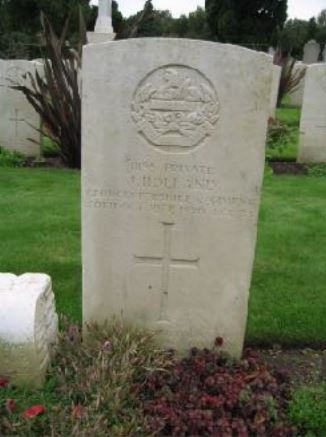7th Battalion, Gloucestershire Regiment

James Holland (his full name may have been Ernest James Holland) was born at Gloucester either at the end of 1888 or the beginning of 1889 (he was baptised on 17 April 1889). He was one of nine children born to Richard Henry Holland (1858-1933), a dock labourer and his wife Margaret Hunter (née Miller: 1861-1917).
At the time of the 1911 Census the family lived at 2 High Orchard Street, Gloucester and the census records that eight of the nine children were living. James was the eldest son, whose occupation was recorded as an iron worker at the Gloucester Wagon Works.
James married Eliza Dix at St Mark’s Church, Gloucester on 17 April 1915. Both he and his wife were aged 27 and by this time, as the marriage register records, he was a serving soldier with the 7th Glosters. They had one child, Phyllis Margaret, born in 1920.
According to his surviving Army Pension Record, James had volunteered for military service on 28 August 1914, stating his age (correctly) as 26 years and four months and his occupation as a forge man. He was posted to the Gloucestershire Regiment and after initial training was appointed as a ‘pioneer cold shoer’ — presumably working with horses.
He joined the 7th Battalion and trained at Tidworth, Basingstoke and Blackdown, Aldershot before sailing with the battalion (part of 39 Brigade, 13th (Western) Division) from Avonmouth for Gallipoli on 18 June 1915. Upon arriving at Gallipoli, the battalion was initially deployed in the Helles sector prior to transferring north to the Anzac Cove area. Here it took part in the failed attempt, between 6 to 10 August 1915, to capture the 3000 foot heights of the Sari Bair Ridge.
Following the evacuation of the Gallipoli Peninsula in January 1916 the 7th Glosters transferred to Egypt and on 16 February 1916 arrived in Mesopotamia (modern day Iraq). James’ stay in Mesopotamia lasted until the autumn of 1918. On the 30 July that year he was diagnosed with phthisis (tuberculosis) whilst in Baghdad and was invalided to India on 28 October
He remained in India until 9 January 1919, whereupon he was repatriated to the UK, arriving on 21 February 1919. He was posted to the strength of the Glosters’ Depot and discharged from the Army, due to sickness on 10 March 1919. He was issued with a Silver War Badge to denote discharge due to invalidity. He had served for four years and 195 days.
James Holland died on 20 October 1920, age 31. A recently released Pension Record Card indicates that his death was due to pulmonary tuberculosis, attributable to military service and his widow was awarded a pension, from 27 October. A notice of death was placed in the Cheltenham Chronicle of 30 October 1920 and this stated that he died at 31 Worrel Street, Gloucester. He was buried in Gloucester Old Cemetery, where a standard CWGC headstone marks his grave.
The Medal Roll for the 7th Glosters lists three men with the surname of Holland, with similar numbers – James (11195), Thomas (11462) and William (11538). James had brothers named Thomas and William and it seems highly likely that all three joined the 7th Glosters at about the same time, or even on the same day. The youngest, William, would have been 17 when war broke out and probably lied about his age in order to join up with his brothers (he needed to be 19 to serve overseas). He appears to have survived the war. Soldiers Died in the Great War records that Thomas Holland, from Gloucester, was killed in action on 8 August 1915 (during the assault on Sari Bair) and the CWGC ‘Debt of Honour’ register records that, having no known grave, he is commemorated on the Helles Memorial to the Missing of the Gallipoli campaign.
Researched by Graham Adams 3 January 2020
